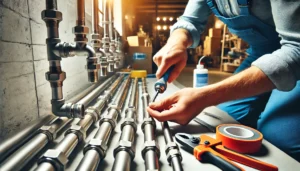In industrial valves, material choice ensures durability, performance, and longevity in various applications. A material’s selection affects the valve’s ability to withstand operational stresses, resist corrosion, and maintain functionality in certain environmental conditions. Industrial valves are used in diverse applications, including oil, gas, water treatment, and chemical processing. As such, material selection is critical for efficiency while minimizing downtime and expensive repairs. Below is a detailed guide to understanding compliance with the requisite performance and safety standards through industrial valves’ material selection.
Important Considerations for Material Selection
- Operating Environment: The temperature, pressure and chemical composition of the valve’s controllers’ fluids or gases are key considerations when selecting a material. For instance, high Inconel or Hastelloy may be required for high temperature applications, whereas certain strength retaining alloys should be used in low temperature settings to prevent brittleness.
- Corrosion Resistance: Materials used for valves needing protection from corrosive substances the material used has to be able to withstand chemical attacks. For example, stainless steel 316 is good for many chemicals. In extreme conditions, the employment of alloy steels and composites with increased corrosion resistance can help to avoid expensive failures and maintenance.
- Mechanical Properties: The fabricating valves, strong and ductile materials that withstand mechanical stresses are necessary. Compared to cast materials, forged steel is a good example because it offers better strength and reliability. In cases where vibration, pressure changes , or fast movement of fluids exists, the material that the valve is made of has to assume all of the mechanical stresses for the valve to work as it should, reliable over time.
- Cost Considerations: Although there are many materials that differ in cost, spending too much on a valve’s construction will lead to an impractical design. Therefore, it is necessary to determine the budget and limit valve materials selection to what is actually needed in terms of performance and what is affordable.
Common Materials Used in Industrial Valves
- Carbon Steel: Carbon steel has a reasonable amount of strength and low cost which makes it appealing for medium temperature and pressure tasks. It should be mentioned that it is prone to corrosion and protecting films or linings may be needed to improve resistance to some chemicals or weathering.
- Stainless Steel: Stainless steel valves are commonly applied in the food processing sector, pharmaceutical industry, and in the water systems where sanitation is important. Stainless steel valves of grades 304 and 316 are also preferred in operations which require high mechanical strength and excellent corrosion resistance.
- Alloy Steels: Inconel, Hastelloy, and Monel are alloy steels developed for use in high-temperature and high-pressure conditions. Their high resistance to heat and corrosion makes them very useful in the aerospace, chemical, and power industries where optimal performance in strenuous environments is a necessity.
- Bronze and Brass: Valves made of bronze and brass have become widely accepted for the steam, water, and some chemicals due to their corrosion durability. However, they are ill suited for applications which require high pressure and high temperature. They function well in low pressure systems and highly endure moderate pressure and temperature conditions.
- Plastics and Composites: Corrosive fluids and gases are handled well by PVC, CPVC, and PTFE because of their robust chemical resistance. Their low-pressure tolerance and outstanding isolation properties make them ideal for many applications, but they are mechanically weak for high pressure and high temperature systems.
Process of Selecting a Material
- Assessing Service Conditions: Start by thoroughly evaluating the operating temperature, pressure, and chemical composition of the media. Effective process handling without degradation is facilitated by these measures. Step one entails picking a material that can withstand the temperature, pressure, and chemical values that are present during operation.
- Considering Mechanical Requirements: The strength, hardness, and ductility prerequisites of the valve must be defined. The chosen metal for the valve must be able to sustain internal pressures and mechanical shocks from the fluid flow and system pressure spikes. The valve should be designed to meet the demands of a functioning environment.
- Evaluating Corrosion Resistance: Shield against the corrosion that aggressive mediators like acids, alkaline solutions, and seawater inflict on materials. They are often selected due to their stainless corrosion resistance – these include stainless steel, specific alloys, and certain coatings.
- Cost Analysis: Once these considerations are made it will be easier to analyze the long-term cost to be incurred from the material selection. One can now examine the direct purchase expenses, along with replacement frequency, lifecycle performance, maintenance expenses, and other peripheral expenses. Performance and expenditure must be in equilibrium for ideal organizational reliability.
- Consulting Standards and Guidelines: Ensure compliance with federal regulatory standards set by ASTM, ASME, and API for adequate material application. Guidelines that promote superior safety and reliability are created by these requirements.
Additional Considerations for Valve Material Selection
- Temperature Extremes: Parts that operate in extremely low or high-temperature environments like cryogenics require alloys that can withstand those conditions without becoming very brittle. Withstands high-temperature systems often require ceramic-lined valves or some sort of heat resistant material to perform properly at those high temperatures.
- Fluid Characteristics: Fluids can be in different states: gas, liquid and even slurry, so the viscosity, corrosiveness and particulate concentration needs to be taken in account when selecting valves. For example, slurry applications may need the use of more abrasive materials to ensure that solid particles do not wear through the valve.
- Valve Size and Functionality: Bigger size valves or valves in more complex systems are subjected to greater stresses, therefore, may require more durable materials. Throttling valves or valves that require a higher level of precision in control may need more particular materials that endure the pressure without sustaining damage over time due to wear or fatigue.
Conclusion
Choosing the right materials for industrial valves is important to guarantee the correct functioning of the components during operation. The right material choice affects the durability of the valve, its performance, and the system’s efficiency. Engineers and policymakers should pay attention to service conditions, corrosion resistance, mechanical properties, and cost in selecting valve materials. This will ensure a reliable valve, lower the maintenance costs, and extend the service life of essential assets for chemical processing, water treatment, oil, and gas industries. While material selection might be daunting, it is a critical process that, when executed correctly, enables the components to satisfy the set operational parameters resulting in cost savings, greater operational safety, and efficiency.










